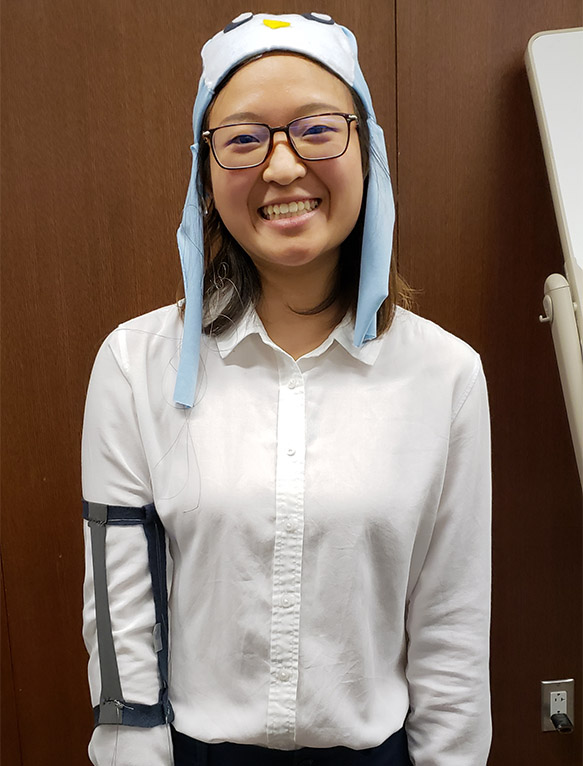HMC Students at Health Hackathon
November 14, 2018
Patients and clinicians treating rare diseases face myriad challenges. By definition, the rarity of a disease can mean that research on the condition, established protocol for diagnosis and treatment, and treatment itself are also rare.
“Rare diseases” was the theme of the third annual Mount Sinai Health Hackathon in New York City, where four Harvey Mudd College students competed last month. Sophia Cheng ’21, Valerie Kwee ’19, Victoria Marino ’20 and Heather Wing ’21 spent part of their fall break developing technology for at-home patient monitoring for parents with children suffering from West Syndrome, a condition characterized by infantile epileptic spasms, abnormal brain wave patterns and intellectual disability.
The 48-hour multidisciplinary competition focused on creating novel technology solutions for problems in healthcare. Prior to the start of the competition, teams were given access to video interviews of patients and doctors discussing the challenges they face that involve rare disease. “We did not know which rare disease we wanted to focus on,” says Kwee, “but we did know we wanted to help monitor infantile seizures. West Syndrome just happened to be a specific rare disease with epileptic symptoms that could use the tool we created.”
The students’ first task at the event was to pitch their idea to an audience and recruit people to join them in developing their device, the West Wave. “It’s a kit developed for at-home use that can collect data in real time to help doctors monitor infants with rare diseases,” says Kwee.
Joined by students from other schools, employees of Mt. Sinai and an entrepreneur from Washington, D.C., the team spent Friday evening to Sunday afternoon developing prototypes and marketing pitches. “The project was challenging in that we needed to make devices that were comfortable, marketable and functioning,” Kwee says.
Concealing conductive thread and flexible electrodes in a comfortable, kid-friendly beanie, the West Wave is a wearable electroencephalogram (EEG) that measures brain activity using OpenBCI (open-source, brain-computer interface platform) software and hardware. The beanie is part of a kit that also includes informational material on helping those with West Syndrome and an arm device that detects muscle contraction.
“Our idea was to have babies wear this wireless EEG and armband when they sleep, and when there are abnormal activities detected, parents would receive an alert on their phones,” says Cheng. “We actually got a decent amount of the hardware and part of the software to work.”
“The arm device uses a resistance sensor fabric that will change resistance as the material is stretched or bent,”Kwee says. “We used conductive thread to make the device comfortable for users. The arm band is attached to an Arduino microcontroller that plots the changes in resistance, which corresponds to when the wearer is having a spasm and contracting their muscles.”
In the end, the West Wave was not selected as a finalist in the competition. “I think all of us were disappointed, to some extent, that our project wasn’t presented the way we had wanted to,” says Cheng a mathematics and computational biology major. “We only had three minutes to present; we had a lot of ideas and we executed a lot of them, yet we weren’t able to present them fully.”
However, as biology and chemistry professor Karl Haushalter points out, “I think that the more interesting story is what they were able to create, the interdisciplinary nature of the project and the patients that it would serve.” Haushalter coordinated the team’s trip to the hackathon through a connection with the Mount Sinai medical school.
“The experience was unforgettable,” says Kwee, who is majoring in engineering. “We were able to meet people from many trades that we likely would never have had the opportunity of meeting.”
Though this team will likely not continue development of the West Wave, the project may be taken on by another group. “I really would like to continue working on it and possibly have this turned into a future Clinic project,” says Marino, an engineering major. “Mt. Sinai engineers were particularly interested in the product idea and will likely expand on it,” Kwee says.
This was the second year that a team from Harvey Mudd competed in the Health Hackathon. “I was pleasantly surprised that other students there know about Mudd,” says Cheng. “The presenters and the sponsor also mentioned Mudd a couple times during the introduction.”
In February, last year’s team was invited to enter its project, the Teddy Tracker, in a Shark Tank-style showcase, during which they presented a pitch to a panel of entrepreneurs and received positive feedback. The Teddy Tracker has also made it through the first round of selection for the Lemelson-MIT student prize, which honors promising student inventors. Funding for both trips came from the Shanahan Student-Directed Project Fund.
“I would definitely recommend Mudd students participate in the Health Hackathon,” says Kwee, pointing out that, with the preparation that all Harvey Mudd students receive in the Core, students of any major are already equipped to participate.
“I am glad I had the chance to participate in the event before I graduated,” Kwee says. “It really showed me how much I’ve learned in the past three-and-a-half years and reminded me of the impact I can make. The event helped me build confidence in myself, and I am more excited to see what the future will hold for me as an engineer.”
